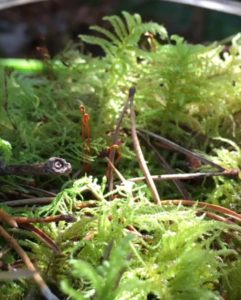 I’m in Oregon, knee deep in moss. Grey green lichen hangs from the branches above me in great big frilly clumps creating a landscape so rich with life, I can almost feel it humming beneath and around me. The moss is soft and springy and I marvel at all the different shades of green, from the brown – green of last year to the almost neon green of the coming spring.
I’m in Oregon, knee deep in moss. Grey green lichen hangs from the branches above me in great big frilly clumps creating a landscape so rich with life, I can almost feel it humming beneath and around me. The moss is soft and springy and I marvel at all the different shades of green, from the brown – green of last year to the almost neon green of the coming spring.
I have always loved exploring the intricate detail of a mossy landscape. Armed with a magnifying glass, I can get lost in this tiny world where ants are as big as dinosaurs and mossy fronds tower above them like sequoias.
 I approach the study of moss and lichen more from an aesthetic viewpoint rather than a scientific one, for classification of these plants can get incredibly complicated, starting with the fact that a lichen is actually not even a plant. It is, instead, a fascinating combination of algae and fungus. Dissect a piece of lichen and you will find two distinct organisms with their own distinct DNA. Amazingly enough, these two organisms are not even remotely related but in fact represent two different kingdoms. Algae are in the Prosita Kingdom and fungus belongs to the Kingdom Fungi
I approach the study of moss and lichen more from an aesthetic viewpoint rather than a scientific one, for classification of these plants can get incredibly complicated, starting with the fact that a lichen is actually not even a plant. It is, instead, a fascinating combination of algae and fungus. Dissect a piece of lichen and you will find two distinct organisms with their own distinct DNA. Amazingly enough, these two organisms are not even remotely related but in fact represent two different kingdoms. Algae are in the Prosita Kingdom and fungus belongs to the Kingdom Fungi
The algae and fungus that comprise lichen are in a symbiotic relationship with one another. Neither can survive without the other. Talk about co-dependency! Algae, which can only grow in water, needs the fungus to be able so survive on land and the fungus, which has no chlorophyll, needs the algae for photosynthesis. Together, they produce some beautiful and wicked looking organisms.
Mosses are true plants but do not have roots and do not produce seeds. Instead, they produce spores which occur on stalks with a single capsule. There are 22,000 different kinds of mosses, world wide, representing a vast array of growth forms.
Happily, after years of neglect, my back yard is more than half moss. If I were to make the effort, I could greatly increase the amount of moss as it is easy to transplant and would spread quickly if I kept it moist and removed the weeds.
But, I’m not too inclined to make the effort. I like the combination of weeds and moss and I love being able to spend my garden efforts elsewhere. When it comes to my backyard, I’m quite content to roll no stones and let just them sit and gather moss.
I have to admit that as proud and happy as I am with my Georgia moss, it can’t compare to the mossy carpets of grass found in the Pacific Northwest. I’m in Oregon now, visiting friends and family, and in a state of wonder at the beauty and variety of mosses and lichens found in these woods. Tens of thousands of years have provided the perfect growing conditions for these plants. Well, actually, lichens are not really plants.

Love reading your blog! I learn something new every time, like the science of lichen!